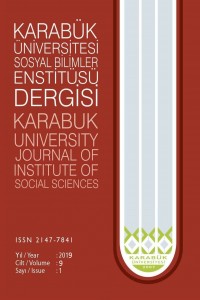The Use of Hedging Strategies in Research Articles: A Corpus Comparison of Native and Non-Native Researchers
Öz
Research writing in the academia has various important functions such as providing a means of sharing research findings across the world, creating opportunities for discussion of ideas and allowing for researchers to develop their reputation. Thus, research writing and publications in academic journals have become important means of communication among researchers. This communication through research papers has its own norms and conventions which are generally indicated by the academic journals themselves. Skilled research writers follow this scientific style with ease while novice and non-native research writers have to learn this type of rhetoric in order to get published in academic journals. While non-native research writers may have the necessary research writing skills in their native language, they may have difficulty transferring these skills into a non-native language. To this end, the purpose of the present study explores the use of hedging strategies by non-native Turkish researchers writing in the English language and their native peers from a comparative perspective. The genre used for comparison was published social sciences articles. In the scope of the study, two sub-corpora consisting of 100 lexico-grammatically tagged articles each extracted from the AAC-corpus and the TAC corpus were used in the study which were compiled by the researcher. AntConc concordancing program was employed to compare the hedging strategies quantitatively.
Anahtar Kelimeler
Kaynakça
- Crismore, A., Markkanen, R. & Steffensen, M.S. (1993). Metadiscourse in persuasive writing: a study of texts written by American and Finnish university students. Written Communication, 10, 39–71. Hyland, K. (1996). Writing Without Conviction? Hedging in Scientific Research Articles. Applied Linguistics, 17(4), 433-454. Hyland, K. (1998). Hedging in Scientific Research Articles, Amsterdam: John Benjamins Publishing Company. Hyland, K., (2005). Metadiscourse: Exploring Interaction in Writing. London: Continuum. Hyland, K. & Tse, P. (2005). Hooking the reader: a corpus study of evaluative that in abstracts. English for Specific Purposes, 24, 23–139. Hu, G. & Cao, F. (2011). Hedging and boosting in abstracts of applied linguistics articles: A comparative study of English- and Chinese-medium journals. Journal of Pragmatics, 43, 2795–2809. Kim, L. C. &, Lim, J. M. (2015). Hedging in Academic Writing - A Pedagogically-Motivated Qualitative Study. Procedia – Social and Behavioral Sciences, 197, 600 – 607. Lakoff, G. (1972). Hedges: A Study in Meaning Criteria and the Logic of Fuzzy Concepts. Chicago Linguistic Society Papers, 8, 183-228. Lyons, J. (1977) Semantics. New York: Cambridge University Press. Myers, G. (1989). The Pragmatics of Politeness in Scientific Articles. Applied Linguistics, 10 (1), 1-35. Taşpınar, H. K. (2017). Epistemic Modality in Academic Writing: A Discipline-Based Analysis. The Literacy Trek 3(1), 47-65. Vande Kopple, W.J. (1985). Some exploratory discourse on metadiscourse. College, Composition and Communication 36, 82–93. Vold, E.T. (2006). Epistemic modality markers in research articles: a cross-linguistic and cross-disciplinary study. International Journal of Applied Linguistics, 16, 61–87.
Ayrıntılar
| Birincil Dil | İngilizce |
|---|---|
| Bölüm | Makaleler |
| Yazarlar | |
| Yayımlanma Tarihi | 15 Mart 2019 |
| Yayımlandığı Sayı | Yıl 2019 Cilt: 9 Sayı: 1 |


